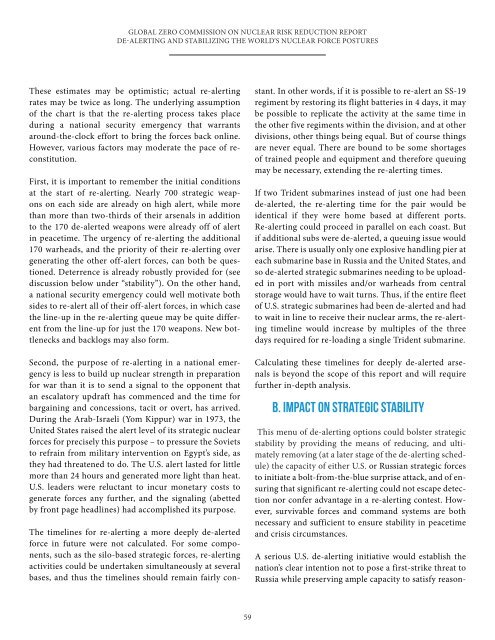global_zero_commission_on_nuclear_risk_reduction_report
global_zero_commission_on_nuclear_risk_reduction_report
global_zero_commission_on_nuclear_risk_reduction_report
Create successful ePaper yourself
Turn your PDF publications into a flip-book with our unique Google optimized e-Paper software.
GLOBAL ZERO COMMISSION ON NUCLEAR RISK REDUCTION REPORTDE-ALERTING AND STABILIZING THE WORLD’S NUCLEAR FORCE POSTURESThese estimates may be optimistic; actual re-alertingrates may be twice as l<strong>on</strong>g. The underlying assumpti<strong>on</strong>of the chart is that the re-alerting process takes placeduring a nati<strong>on</strong>al security emergency that warrantsaround-the-clock effort to bring the forces back <strong>on</strong>line.However, various factors may moderate the pace of rec<strong>on</strong>stituti<strong>on</strong>.First, it is important to remember the initial c<strong>on</strong>diti<strong>on</strong>sat the start of re-alerting. Nearly 700 strategic weap<strong>on</strong>s<strong>on</strong> each side are already <strong>on</strong> high alert, while morethan more than two-thirds of their arsenals in additi<strong>on</strong>to the 170 de-alerted weap<strong>on</strong>s were already off of alertin peacetime. The urgency of re-alerting the additi<strong>on</strong>al170 warheads, and the priority of their re-alerting overgenerating the other off-alert forces, can both be questi<strong>on</strong>ed.Deterrence is already robustly provided for (seediscussi<strong>on</strong> below under “stability”). On the other hand,a nati<strong>on</strong>al security emergency could well motivate bothsides to re-alert all of their off-alert forces, in which casethe line-up in the re-alerting queue may be quite differentfrom the line-up for just the 170 weap<strong>on</strong>s. New bottlenecksand backlogs may also form.Sec<strong>on</strong>d, the purpose of re-alerting in a nati<strong>on</strong>al emergencyis less to build up <strong>nuclear</strong> strength in preparati<strong>on</strong>for war than it is to send a signal to the opp<strong>on</strong>ent thatan escalatory updraft has commenced and the time forbargaining and c<strong>on</strong>cessi<strong>on</strong>s, tacit or overt, has arrived.During the Arab-Israeli (Yom Kippur) war in 1973, theUnited States raised the alert level of its strategic <strong>nuclear</strong>forces for precisely this purpose – to pressure the Sovietsto refrain from military interventi<strong>on</strong> <strong>on</strong> Egypt’s side, asthey had threatened to do. The U.S. alert lasted for littlemore than 24 hours and generated more light than heat.U.S. leaders were reluctant to incur m<strong>on</strong>etary costs togenerate forces any further, and the signaling (abettedby fr<strong>on</strong>t page headlines) had accomplished its purpose.The timelines for re-alerting a more deeply de-alertedforce in future were not calculated. For some comp<strong>on</strong>ents,such as the silo-based strategic forces, re-alertingactivities could be undertaken simultaneously at severalbases, and thus the timelines should remain fairly c<strong>on</strong>stant.In other words, if it is possible to re-alert an SS-19regiment by restoring its flight batteries in 4 days, it maybe possible to replicate the activity at the same time inthe other five regiments within the divisi<strong>on</strong>, and at otherdivisi<strong>on</strong>s, other things being equal. But of course thingsare never equal. There are bound to be some shortagesof trained people and equipment and therefore queuingmay be necessary, extending the re-alerting times.If two Trident submarines instead of just <strong>on</strong>e had beende-alerted, the re-alerting time for the pair would beidentical if they were home based at different ports.Re-alerting could proceed in parallel <strong>on</strong> each coast. Butif additi<strong>on</strong>al subs were de-alerted, a queuing issue wouldarise. There is usually <strong>on</strong>ly <strong>on</strong>e explosive handling pier ateach submarine base in Russia and the United States, andso de-alerted strategic submarines needing to be uploadedin port with missiles and/or warheads from centralstorage would have to wait turns. Thus, if the entire fleetof U.S. strategic submarines had been de-alerted and hadto wait in line to receive their <strong>nuclear</strong> arms, the re-alertingtimeline would increase by multiples of the threedays required for re-loading a single Trident submarine.Calculating these timelines for deeply de-alerted arsenalsis bey<strong>on</strong>d the scope of this <strong>report</strong> and will requirefurther in-depth analysis.B. IMPACT ON STRATEGIC STABILITYThis menu of de-alerting opti<strong>on</strong>s could bolster strategicstability by providing the means of reducing, and ultimatelyremoving (at a later stage of the de-alerting schedule)the capacity of either U.S. or Russian strategic forcesto initiate a bolt-from-the-blue surprise attack, and of ensuringthat significant re-alerting could not escape detecti<strong>on</strong>nor c<strong>on</strong>fer advantage in a re-alerting c<strong>on</strong>test. However,survivable forces and command systems are bothnecessary and sufficient to ensure stability in peacetimeand crisis circumstances.A serious U.S. de-alerting initiative would establish thenati<strong>on</strong>’s clear intenti<strong>on</strong> not to pose a first-strike threat toRussia while preserving ample capacity to satisfy reas<strong>on</strong>-59


